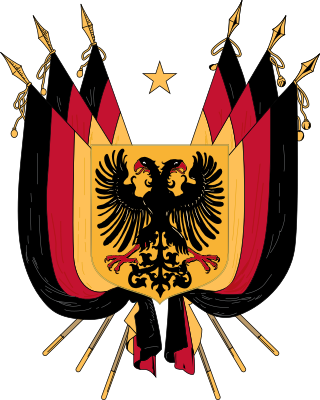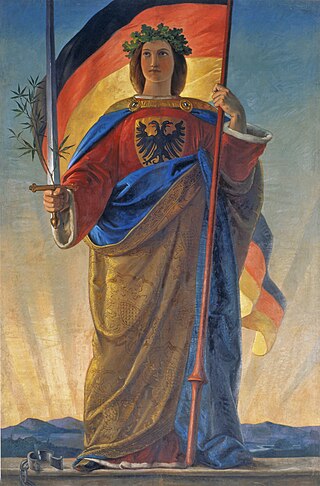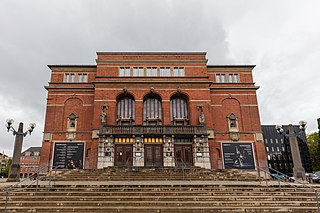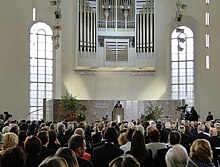
The Frankfurt Parliament was the first freely elected parliament for all German states, including the German-populated areas of the Austrian Empire, elected on 1 May 1848.

The Frankfurt Book Fair is the world's largest trade fair for books, based on the number of publishing companies represented. The five-day annual event in mid-October is held at the Frankfurt Trade Fair grounds in Frankfurt am Main, Germany. The first three days are restricted exclusively to professional visitors; the general public attend the fair on the weekend.

Germania is the name of a painting that was probably created in March 1848. It hung in the St. Paul's Church (Paulskirche) in Frankfurt, Germany. At that time, first the so-called Pre-Parliament and then the Frankfurt National Assembly, the first all-German parliament, met there. The National Assembly was a popular motif of the time, so the Germania painting also became very well-known. After the National Assembly was violently terminated in May 1849, the painting was taken down. In 1867 it was moved to the German National Museum in Nuremberg.

For almost five centuries, the German city of Frankfurt was a city-state within two major Germanic entities:

Frankfurt Cathedral, officially Imperial Cathedral of Saint Bartholomew, is a Roman Catholic Gothic church located in the heart of Frankfurt am Main, Germany. It is dedicated to Saint Bartholomew.

St. Catherine's Church is the largest Protestant church in Frankfurt am Main, Germany. It is a parish church in the old city centre near one of the most famous city squares, the Hauptwache. The church is dedicated to the martyred early Christian saint Catherine of Alexandria.

The Casino faction was a moderate liberal faction within the Frankfurt Parliament formed on 25 June 1848. Like most of the factions in the parliament, its name was a reference to the usual meeting place of its members in Frankfurt am Main. Casino was the largest and most influential faction at Paulskirche. Its members were for the most part national liberals.

The Frankfurt Constitution or Constitution of St. Paul's Church (Paulskirchenverfassung), officially named the Constitution of the German Empire of 28 March 1849, was an unsuccessful attempt to create a unified German nation state in the successor states of the Holy Roman Empire organised in the German Confederation. Adopted and proclaimed by the Frankfurt Parliament after the Revolutions of 1848, the constitution contained a charter of fundamental rights and a democratic government in the form of a constitutional monarchy. King Frederick William IV of Prussia was designated head of state as "Emperor of the Germans", a role he rejected.

Opernhaus Kiel is the major venue for opera, ballet, and orchestral performances in Kiel, and home to Theater Kiel. It is a Grade II listed building.

Johann Konrad Wilhelm Löhe was a pastor of the Lutheran Church, Confesional Lutheran writer, and is often regarded as being a founder of the deaconess movement in Lutheranism and a founding sponsor of the Lutheran Church–Missouri Synod (LCMS). From the small town of Neuendettelsau, he sent pastors to North America, Australia, New Guinea, Brazil, and Ukraine. His work for a clear confessional basis within the Bavarian church sometimes led to conflict with the ecclesiastical bureaucracy. His chief concern was that a parish find its life in the eucharist, and from that source evangelism and social ministries would flow. Many Lutheran congregations in Michigan, Ohio, and Iowa were either founded or influenced by missionaries sent by Löhe. He is commemorated on 2 January by the calendars of both the LCMS and the Evangelical Lutheran Church in America.

The factions in the Frankfurt Assembly were groups that developed among delegates to the Frankfurt Parliament that met from 18 May 1848 to 31 May 1849 in the Paulskirche in Frankfurt am Main. They coalesced as groups of like-minded representatives started meeting, and were named after the various hostelries at which they met.

The Dominican Monastery is a former Christian monastery in Frankfurt am Main. It is the seat of Protestant Regional Association, a group of Protestant congregations and deaneries in the city, and serves as the convention site for the Synod of the Protestant Church in Hesse and Nassau, held usually twice a year. The former monastery compound includes a Lutheran church building, called the Church of the Holy Spirit.

Germania is a painting created by Philipp Veit in 1834-1836. Germania in general is a female personification of Germany. This painting is one of two side pictures of the big mural painting Introduction of the Arts to Germany by Christianity. The other side picture presents Italia. The fresco transferred to canvas measures 285 by 192 cm and is exhibited in the Städelsches Kunstinstitut in Frankfurt am Main.

St. Nikolai is the name of a Protestant parish and its church in Kiel, the capital of Schleswig-Holstein, Germany. It is the town's oldest building, at the Alter Markt. It was dedicated to Saint Nicholas. In the 19th century, it was remodeled in Gothic Revival style. Destroyed in World War II, it was rebuilt with a simpler contemporary interior. It features notable artworks such as a bronze baptismal font from 1340, an altar from 1460, a triumphal cross from 1490, a wood-carved pulpit from 1705, and outside a bronze by Ernst Barlach from 1928.

Börsenverein des Deutschen Buchhandels is a trade association of the German publishing industry, based in Frankfurt. It was founded there in 1948 and merged with a similar Leipzig organisation in 1991 after German reunification. It organises the annual Frankfurt Book Fair, where the peace prize Friedenspreis des Deutschen Buchhandels has been awarded since 1950.

The Pellerhaus monument is an archive and library building on Egidienplatz in Nuremberg's old city centre. It extends over the area of the historic Pellerhaus and the historic Imhoff house to the east of it, which was rebuilt after the war in the contemporary design of the late 1950s.

The Roseneck was a group of half-timbered houses in Frankfurt am Main. The small square was a tourist attraction and, alongside the Five-Finger Square, was one of the most popular postcard motifs in the picturesque old town (altstadt) of Frankfurt. The Roseneck was destroyed in the air raids on Frankfurt in 1944. When it was rebuilt in 1952, the properties and alleys of the ensemble were redesigned with simple residential and commercial buildings.

The Salzhaus is a historic building in the German city Frankfurt am Main. It forms the northeastern part of the Frankfurt City Hall complex (Römer), on the Römerberg square in the centre of the Altstadt.
Landsberg was the name of faction that started in September 1848 as part of the National Assembly in Frankfurt. As with most factions of the National Assembly, the name refers to the usual place of assembly of the faction members in Frankfurt am Main.

Friedenskirche is a Lutheran church in Stuttgart, Baden-Württemberg, Germany, and the parish church of the Evangelische Friedensgemeinde Stuttgart. The first church, in neo-Romanesque style was consecrated in 1892. Destroyed during World War II, with the exception of the tower, it was rebuilt in the 1960s in concrete, and consecrated anew in 1966. The church also serves as a concert venue.
























